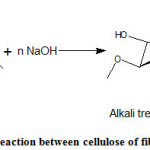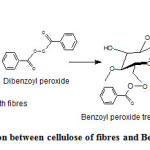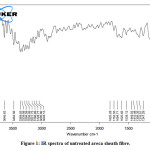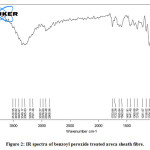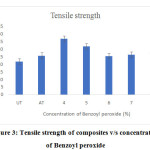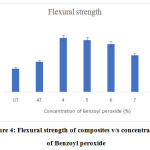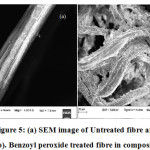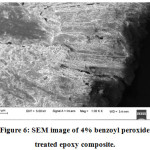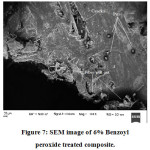Surface Modification of Areca Fibre by Benzoyl Peroxide and Mechanical Behaviour of Areca-Epoxy Composites
Sakshi Shantharam Kamath and Basavaraju Bennehalli*
and Basavaraju Bennehalli*
Department of Chemistry, Alva’s Institute of Engineering & Technology, Affiliated to Visvesvaraya Technological University, Mijar-574225, Karnataka, India.
Corresponding Author E-mail: basavaraju_b@yahoo.co.in
DOI : http://dx.doi.org/10.13005/msri/180106
Article Publishing History
Article Received on : 31-Dec-2020
Article Accepted on : 03-Mar-2021
Article Published : 04 Mar 2021
Plagiarism Check: Yes
Reviewed by: Dr. Azeem Pasha
Second Review by: Dr. Mohanamurugan S
Final Approval by: Dr. Ozan Toprakci
Article Metrics
ABSTRACT:
Natural fibre composites are playing great role in current life scenario where the focus is more on replacing synthetic fibre composites with natural fibre composites. In this current study, investigation was done on tensile and flexural behaviour of benzoyl peroxide treated areca sheath fibre epoxy composites. The surface modification of the fibre was confirmed by FTIR analysis. Treatment concentration was the major criteria which effects mechanical properties of the composites. At 4% concentration tensile strength and flexural strength was found to be maximum which was reported as 37.05 N/mm
2 and 235.5 N/mm
2 respectively which gradually decreased with increasing concentration of benzoyl peroxide. SEM analysis proved that at lesser concentration, the bonding between fibre and resin was effective which reduced as the concentration of benzoyl peroxide increased. This results in ineffective stress transfer between reinforcing material and the matrix which was the reason for failure of composites manufactured at higher treatment concentration.
KEYWORDS:
Areca Sheath Fibre; Benzoyl Peroxide; FTIR Studies; Fibre Epoxy Composite; Flexural Strength; SEM Analysis; Tensile Strength
Copy the following to cite this article:
Kamath S. S, Bennehalli B. Surface Modification of Areca Fibre by Benzoyl Peroxide and Mechanical Behaviour of Areca-Epoxy Composites. Mat. Sci. Res. India;18(1).
|
Copy the following to cite this URL:
Kamath S. S, Bennehalli B. Surface Modification of Areca Fibre by Benzoyl Peroxide and Mechanical Behaviour of Areca-Epoxy Composites. Mat. Sci. Res. India;18(1). Available from: https://bit.ly/3rhbS2a
|
Introduction
Fibre reinforced polymer composites play a major role in wide variety of applications like aircraft, sport equipment, marine applications, automobile industries because of its higher mechanical properties and hence they serve as a promising material in the field of composite[1], [2]. But with respect to environmental concern, synthetic fibre composites create a negative vibe because of its adverse properties like non-renewability, high cost and its hazardous nature. As a result of this, researchers began to think about natural fibre composites because of its advantages like easy availability, less density, renewability and eco-friendly nature[3], [4]. The major drawback associated with natural fibre composite is its hydrophilic nature and its inability to interconnect with hydrophobic resin. Many researchers have investigated chemically modifying fibre surface and finding their compatibility with different resins and to study effect of these chemical treatments on different properties of natural fibre composites[5].Different possible chemical treatments identified are alkali treatment, potassium permanganate, acetylation, benzoylation, stearic acid, peroxide, sodium chlorite treatment on different fibres like areca husk fibre, sisal, abaca, hemp, bagasse, flax [6], where the treatment improves the surface morphology, surface becomes rougher and hence, the interfacial bonding improves interaction between fibre and resin andthe mechanical property of composites is improved. In the current study, more focus is on peroxide treatment and their effect on composite property. The peroxide treatment is carried out using benzoyl peroxide or dicumyl peroxide and impact of treatment on composite properties were studied by few of the researchers which are documented as follows. Augustine et al in year 1997, analysed effect of peroxide treatment on electric property of the sisal fibre reinforced LDPE composite. Studies revealed that peroxides undergo free radical mechanism which effectively helps in bonding between fibre and resin thereby improving the dielectric property of fibre composites[7]. Elena et al in year 2014 studied crosslink density, swelling behavior and water uptake behavior on benzoyl peroxide treated hemp and rubber composites. The treatment revealed positive results in the tests conducted[8]. Taslima et al in year 2017 studied the mechanical behavior of benzoyl peroxide treated teak sawdust reinforced HDPE composites. The investigation revealed that tensile strength and impact strength of treated composites were high in comparison with untreated teak sawdust HDPE composites. And the water uptake behavior of untreated composites was more compared to treated composites [9]. Joseph et al in year 1996 carried out chemical treatments on sisal fibres and studied mechanical property of sisal LDPE composites. Chemical grafting increased the roughness of fibre surface as proved in SEM analysis and mechanical properties of fibre composites increased[10]. Sapieha et al in year 1990 carried out effect of benzoyl peroxide and dicumyl peroxide on bleached hardwood pulp-LLDPE composites. The free radical mechanism involved in the study was depicted and the study revealed that chemical modification improved mechanical property of the composites and effect is high when the concentration of peroxide is lesser [11]. Wang et al in year 2007 investigated effect of peroxide treatment on flax fibre reinforced LDPE, HDPE and LDPE-HDPE mix composites. Investigation revealed that the chemical modification leads to superior physical and mechanical property of the composite[12]. Izwana et al in year 2020 studied the effect of benzoyl treatment on SPF. The treatment duration was different where in composites showed good thermal properties after treatment and 15 min soaking time revealed better mechanical properties for the same [13]. In year 2019, Vijay et al investigated on effect of benzoylation on mechanical properties of Impomeapescaprae fibre reinforced epoxy composites where benzoylation resulted in better properties of the composites manufactured [14]. The literature reveals that there was an attempt made by scientists were different combinations of peroxide treated fibres were used and composites were fabricated using LDPE and HDPE to study the changes in the property of the composite. But the peroxide treated epoxy composite study was rare. As a result of this, in the current study; areca sheath fibres were used, treated with benzoyl peroxide solutions at different concentrations. This was fabricated with epoxy resin and the composites were manufactured to analyse their mechanical properties.
Materials and methodology
Surface Modification by benzoyl peroxide treatment
Areca sheath fibres were initially washed with double distilled water to eliminate dust from the surface[15], [16]. Fibres were dried in an oven at 70℃ for 15 h to remove moisture content. Fibres were next treated with 1% NaOH solution for one hour. The fibres were repeatedly washed with double distilled water to get rid of alkali solution on the surface and then it was washed with concentrated HCl for complete removal of alkali from fibre surface. Final washing was done with distilled water to ensure complete removal of traces of acid from surface of fibres after which they were dried in an oven for complete elimination of water at 70℃ for 15 h. These are specified as alkali pre-treated fibres. The reaction sequence is shown in Scheme 1.
Scheme 1: Reaction between cellulose of fibres and NaOH.
Further, surface modification is carried out by benzoyl peroxide treatment. Benzoyl peroxide solution is prepared at different concentrations like 4%, 5%, 6%, 7% and 8% in acetone. The pre-treated fibres are then dipped in these respective benzoyl peroxide solutions for 30 min duration. Further, fibres were air dried for 24 h. These dried fibres were cut with the fibre length range of 10 mm to 20 mm and used for composite fabrication. Similar treatment was carried out by Vijay et al in year 2013 where the effect of 5% benzoyl peroxide was studied on sisal fibre at different duration like 30 min and 45 min to analyse the crystallinity index and thermal studies [17]. The reaction between alkali treated cellulose and benzoyl peroxide isas shown in Scheme 2[18].
Scheme 2: Reaction between cellulose of fibres and Benzoyl peroxide.
Spectral analysis
FTIR spectroscopy, BRUKER ALPHA FT-IR Spectrometer: ATR mode was used to investigate different chemical bonding existing in raw and chemically modified fibres. The fibres of approximately 10 mm length were taken in the sample holder and FTIR spectra of samples were evaluated in a range between 500 cm-1 and 4000 cm-1.
Composite fabrication
Areca sheath fibres treated with benzoyl peroxide solutions are used to manufacture fibre reinforced epoxy composites. Composites were fabricated using Compression molding unit (Santec) at 55% fibre loading. The curing time used was 24 h under pressure at 40 bar and in the lab temperature was 15 days. Further, composites were cut according to ASTM standards for mechanical characterization.
Tensile and Flexural strength analysis
Composites manufactured were cut according to ASTM standards; ASTM D638-03 [19] and ASTM-D790 [20] for tensile strength and flexural strength analysis respectively. Testing was carried out in Universal testing machine (Mecmesin Multi Test 2.5-xt). The test was conducted at lab temperature of 35±2 ℃.
Field Emission Scanning Electron Microscopy
Benzoyl peroxide treated areca sheath epoxy composites were subjected to FESEM analysis so as to understand the changes in the surface morphology where the surface is scanned by the electrons according to Zig-Zag pattern. The instrument used for analysis was CARL ZEISS SIGMA (03-81). The samples were subjected to gold sputtering before the analysis.
Results and Discussion
FTIR analysis
FTIR spectrum of UT (untreated fibre) is shown in Figure 1. The absorption peak of untreated areca sheath fibres at 3646.63 cm-1 indicates the free ν(OH) of cellulose. Absorption peaks at 3483.56 cm-1, 3369.55 cm-1 and 3339.08 cm-1referred to hydrogen bonded ν(OH) of alcoholic group of cellulose. Figure 2 represents the FTIR spectrum of benzoyl peroxide treated fibre. Absence of absorption peak at 1820.28 cm-1 confirms elimination of hemicellulose and lignin. During the chemical reaction of alkali treated fibres with benzoyl peroxide, there is formation of new carbonyl group with cellulose of fibres. This new carbonyl group absorption at 1753.64 cm-1 and 1722.26 cm-1 confirmed the chemical modification. The detailed IR peak range for different functional groups present in areca fibre is given in our previous work [21]. The current result is in accordance with the same.
Figure 1: IR spectra of untreated areca sheath fibre
Figure 2: IR spectra of benzoyl peroxide treated areca sheath
Tensile strength analysis
Benzoyl peroxide treatment was carried out on areca sheath fibre at different concentrations like 4%, 5%, 6%, 7% and 8%. Tensile strength analysis was carried out for untreated fibre composite and benzoyl peroxide treated fibre epoxy composite to analyse the effect of benzoyl peroxide concentration on the tensile strength. The specimens were cut with dimensions having length, width and thickness of 165 mm x 19 mm x 3 mm respectively. It was revealed that at 4% concentration, the tensile strength was high which was found to be 37.05 N/mm2. As the concentration increases from 4% to 5%, tensile strength decreased to 32.07 N/mm2; which further decreased to 25.6 N/mm2 at 6% concentration. At 7% and 8% concentration, tensile strength was recorded as 26.6 N/mm2 and 27.9 N/mm2 respectively which is higher compared to 5% and 6% but lesser than 4% treated fibre composite. This indicates that as treatment concentration increases, tensile strength of composite decreases. Also, the tensile strength for untreated fibre composite was found to be 22.06 N/mm2 which is less compared to benzoyl peroxide treated composite. As the treatment is carried out, the surface morphology is changed because of which effective interaction between fibre and resin was observed. Hence, there is improvement in the tensile strength of the composite. The tensile strength of untreated composite (UC) and the treated composites along with the standard deviation is shown in the Figure 3.
Figure 3: Tensile strength of composites v/s concentration of Benzoyl peroxide
Flexural strength analysis
The flexural strength determination was carried out for all samples which were cut according to ASTM standards with length 150 mm, width 25 mm and thickness 3 mm. When the fibres were subjected to benzoyl peroxide treatment; the flexural strength increased from 131.25 N/mm2 to 235.5 N/mm2. This indicates that, benzoyl peroxide treatment results in changing surface morphology of fibre as a result of which bonding between fibre and resin improves which thereby enhances flexural strength of composite materials. Flexural strength for untreated fibre composite (UC) and benzoyl peroxide treated composites are shown in the Figure 4. At lower concentration of benzoyl peroxide, the strength will be high and as the concentration increases, it was observed that fibres become supersaturated with chemical resulting in fibre agglomeration. The bonding between fibre and the resin becomes weak and the composite breakdown takes place. Hence, the flexural strength decreases with increasing concentration of benzoyl peroxide.
Figure 4: Flexural strength of composites v/s concentration of Benzoyl peroxide.
FESEM analysis
SEM analysis was carried out to analyse surface morphology of untreated and benzoyl peroxide treated fibres. Figure 5(a) and 5(b) represents the topography of untreated and peroxide treated fibres respectively. Image reveals that untreated fibre surface is smooth because of deposition of wax and lignin. Surface treatment results in removal of wax and other impurities from surface. As a result of this, surface becomes rough which increases surface area of fibre available for interaction with resin. Bonding between fibre and resin increases which improves the load withstanding capacity of the composites manufactured giving better mechanical property for the composite. Similar result was shown by Jothibasu et al in year 2018 which revealed that surface treatment improves the mechanical property of jute composites where fibre pull-out is lesser compared to untreated areca sheath composites [16].
Figure 5: (a) SEM image of Untreated fibre and (b): Benzoyl peroxide treated fibre in composite
SEM image of 4% treated fibre composite is shown in Figure 6. The image reveals that at this optimum concentration, fibre-matrix adhesion is stronger, stress transfer from fibre to resin takes place effectively; as a result of which the tensile property and flexural property of composite was high. Further when SEM imaging was carried out for 7% benzoyl peroxide treated fibre composites as shown in Figure 7, the cracks in the resin surface was observed indicating poor wettability of fibres resulting in poor stress transfer during fracture. Pits were seen which was because of irregular distribution of fibre and resin. During the testing, fibre pull-out was clearly observed at higher concentration of benzoyl peroxide indicating higher concentration treatment leading to weakening the fibre strength which drastically reduces strength of composites manufactured.
Figure 6: SEM image of 4% benzoyl peroxide treated epoxy composite.
Figure 7: SEM image of 6% Benzoyl peroxide treated composite.
Conclusion
Areca sheath fibre composites plays a prominent role in field of natural fibre polymer composites because of its properties like low density, ease of availability and its applications in constructing light weight material. The benzoyl peroxide treatment drastically improves tensile and flexural property of composites when compared to untreated composites. The literature revealed, work carried with respect to different fibres which were modified with peroxide treatment and the composites manufactured using LDPE and HDPE resins. Hence, the attempt was made to study peroxide treated fibre fabrication with epoxy resin. The study revealed positive result where the drastic increase in mechanical property is observed where both tensile strength and flexural strength is found maximum at 4% treatment concentration. Tensile strength improved by 67% and flexural strength increased by 44%. SEM analysis reveals the effective bonding between fibre and the resin at 4% concentration and as concentration increases, the strength gradually decreases. This study proves that epoxy resin can be used in manufacture of benzoyl peroxide treated fibre composites which exhibits good result and thus, it can used in future application studies.
Acknowledgement
Authors would like to thank Principal of Alva’s Institute of Engineering and Technology, Moodbidri, for his kind support extended during this work.
Conflict of Interest
The authors have no conflicts of interest to disclose.
Funding source
No funding received from any organization for the work reported
References
- P. Balakrishnan, M. J. John, L. Pothen, M. S. Sreekala, and S. Thomas, Natural fibre and polymer matrix composites and their applications in aerospace engineering. Elsevier Ltd, 2016.
CrossRef
- S. S. Kamath, D. Sampathkumar, and B. Bennehalli, “A review on natural areca fibre reinforced polymer composite materials,” Ciência Tecnol. dos Mater., vol. 29, no. 3, pp. 106–128, 2017, doi: 10.1016/j.ctmat.2017.10.001.
CrossRef
- R. Ahmad, R. Hamid, and S. A. Osman, “Physical and chemical modifications of plant fibres for reinforcement in cementitious composites,” Adv. Civ. Eng., vol. 2019, 2019, doi: 10.1155/2019/5185806.
CrossRef
- S. S. Kamath et al., “Tensile and flexural behaviour of areca husk fibre reinforced epoxy composite,” Lect. Notes Mech. Eng., pp. 35–43, 2021, doi: 10.1007/978-981-15-5151-2_4.
CrossRef
- S. Ganesh, Y. Gunda, S. R. J. Mohan, V. Raghunathan, and J. D. J. Dhilip, “Influence of Stacking Sequence on the Mechanical and Water Absorption Characteristics of Areca Sheath-palm Leaf Sheath Fibers Reinforced Epoxy Composites,” J. Nat. Fibers, vol. 00, no. 00, pp. 1–11, 2020, doi: 10.1080/15440478.2020.1787921.
CrossRef
- X. Li, L. G. Tabil, and S. Panigrahi, “Chemical treatments of natural fiber for use in natural fiber-reinforced composites: A review,” Journal of Polymers and the Environment. 2007, doi: 10.1007/s10924-006-0042-3.
CrossRef
- A. Paul, K. Joseph, and S. Thomas, “Effect of surface treatments on the electrical properties of low-density polyethylene composites reinforced with short sisal fibers,” Compos. Sci. Technol., vol. 57, no. 1, pp. 67–79, 1997, doi: 10.1016/S0266-3538(96)00109-1.
CrossRef
- E. Manaila, M. D. Stelescu, G. Craciun, and L. Surdu, “Effects of benzoyl peroxide on some properties of composites based on hemp and natural rubber,” Polym. Bull., vol. 71, no. 8, pp. 2001–2022, 2014, doi: 10.1007/s00289-014-1168-4.
CrossRef
- T. Akter, H. P. Nur, S. Sultana, M. R. Islam, M. J. Abedin, and Z. Islam, “Evaluation of mechanical properties of both benzoyl peroxide treated and untreated teak sawdust reinforced high density polyethylene composites,” Cellulose, vol. 25, no. 2, pp. 1171–1184, 2018, doi: 10.1007/s10570-017-1620-3.
CrossRef
- P. V. Joseph et al., “The thermal and crystallisation studies of short sisal fibre reinforced polypropylene composites,” Compos. Part A Appl. Sci. Manuf., vol. 34, no. 3, pp. 253–266, 2003, doi: 10.1016/S1359-835X(02)00185-9.
CrossRef
- S. Sapieha, P. Allard, and Y. H. Zang, “Dicumyl peroxide‐modified cellulose/LLDPE composites,” J. Appl. Polym. Sci., vol. 41, no. 9–10, pp. 2039–2048, 1990, doi: 10.1002/app.1990.070410910.
CrossRef
- B. Wang, S. Panigrahi, and L. Tabil, “Application of Pretreated Flax Fibres in Composites,” CSAE/SCGR 2003 Meet., no. 03, 2003, [Online]. Available: http://www.engr.usask.ca/societies/csae/PapersCSAE2003/CSAE03-357.pdf.
- S. M. Izwan, S. M. Sapuan, M. Y. M. Zuhri, and A. R. Mohamed, “Effects of Benzoyl Treatment on NaOH Treated Sugar Palm Fiber: Tensile, Thermal, and Morphological Properties,” J. Mater. Res. Technol., vol. 9, no. 3, pp. 5805–5814, 2020, doi: 10.1016/j.jmrt.2020.03.105.
CrossRef
- A. Vinod et al., “Characterization of raw and benzoyl chloride treated Impomea pes-caprae fibers and its epoxy composites,” Mater. Res. Express, vol. 6, no. 9, 2019, doi: 10.1088/2053-1591/ab2de2.
CrossRef
- R. Vijay, D. L. Singaravelu, A. Vinod, M. R. Sanjay, and S. Siengchin, “Characterization of Alkali-Treated and Untreated Natural Fibers from the Stem of Parthenium Hysterophorus,” J. Nat. Fibers, vol. 18, no. 1, pp. 80–90, 2021, doi: 10.1080/15440478.2019.1612308.
CrossRef
- S. Jothibasu, S. Mohanamurugan, R. Vijay, D. Lenin Singaravelu, A. Vinod, and M. R. Sanjay, “Investigation on the mechanical behavior of areca sheath fibers/jute fibers/glass fabrics reinforced hybrid composite for light weight applications,” J. Ind. Text., 2018, doi: 10.1177/1528083718804207.
CrossRef
- V. K. Kaushik, A. Kumar, and S. Kalia, “Effect of Mercerization and Benzoyl Peroxide Treatment on Morphology, Thermal Stability and Crystallinity of Sisal Fibers,” Int. J. Text. Sci., vol. 1, no. 6, pp. 101–105, 2013, doi: 10.5923/j.textile.20120106.07.
CrossRef
- M. Masłowski, J. Miedzianowska, and K. Strzelec, “Influence of peroxide modifications on the properties of cereal straw and natural rubber composites,” Cellulose, vol. 25, no. 8, pp. 4711–4728, 2018, doi: 10.1007/s10570-018-1880-6.
CrossRef
- ASTM D638-14, “Standard Practice for Preparation of Metallographic Specimens,” ASTM Int., vol. 82, no. C, pp. 1–15, 2016, doi: 10.1520/D0638-14.1.
- ASTM, “D790-03-Standard Test Method for Flexural Properties of Unreinforced and Reinforced Plastics and Electrical Insulation Materials,” ASTM Stand., pp. 1–11, 2015, [Online]. Available: http://scholar.google.com/scholar?hl=en&btnG=Search&q=intitle:Standard+Test+Methods+for+Flexural+Properties+of+Unreinforced+and+
Reinforced+Plastics+and+Electrical+Insulating+Materials#0.
- R. Patel, G. Ranganagowda, S. Shantharam, B. Bennehalli, and A. Muddanna, “ScienceDirect Spectral studies on chemically modified single areca fibre,” Mater. Today Proc., vol. 5, no. 14, pp. 28018–28025, 2018, doi: 10.1016/j.matpr.2018.10.042.
CrossRef
Views: 886
 This work is licensed under a Creative Commons Attribution 4.0 International License.
This work is licensed under a Creative Commons Attribution 4.0 International License.
 and Basavaraju Bennehalli*
and Basavaraju Bennehalli*
 Material Science Research India An International Peer Reviewed Research Journal
Material Science Research India An International Peer Reviewed Research Journal

